JavaScriptが無効になっています。
ブラウザの設定をご確認ください。
国立療養所邑久光明園の歴史
|
In the beginning: Hansen’s disease is caused by the infection of Mycobacterium leprae and was formally called “leprosy” or “Hansen’s Disease”. The word “Hansen” comes after Dr.Armauer Hansen of Norway who first found Mycobacterium leprae in 1873. It is now commonly called Hansen’s Disease. In the text hereafter, the word “leprosy” is often used. That is because legislative terms, medical terms or names of institutions are unable to change. Therefore the word “leprosy” is used as it is. |
外島保養院から長島へ1907 MarchOn the government’s authority, Act No.11 of 1907,"The matters on Leprosy prevention" was issued. It stated that: (1) A physician who diagnoses Hansen’s disease must report it. (2) The house the patient has lived in must be disinfected. (3)A patient who has no means of receiving medical treatment or support must be taken care of in the institution. (4) The State Minister in charge assigns more than two prefectures and orders to establish a sanatorium within to accommodate the patient. In July, for the purpose of controlling patients, prefectures in Japan were divided into five districts and a sanatorium was to be established in each district. The five districts and the prefectures belonged to each district were as follows: The first district: Tokyo (except Izu-7-island and Ogasawara island), Kanagawa, Niigata, Saitama, Gunma, Chiba, Ibaragi, Tochigi, Aichi, Shizuoka, Yamanashi, Nagano The second district : Hokkaido, Miyagi, Iwate, Aomori, Fukushima, Yamagata, Akita The third district : Kyoto, Osaka, Hyogo, Nara, Mie, Gifu, Shiga, Fukui, Ishikawa, Toyama, Tottori, Wakayama The fourth district : Shimane, Okayama, Hiroshima, Yamaguchi, Tokushima, Kagawa, Ehime, Kochi, The fifth district : Nagasaki, Fukuoka, Oita, Saga, Kumamoto, Miyazaki, Kagoshima, Okinawa 1908 A sanatorium in the third district was to be established in Nishiyodogawa-ku, Osaka.The area of 66000 ㎡ was bought for twenty-nine thousand yen and the place was named “Sotojima”. The construction of the facility started. 1909 On April the first, the sanatorium opened. It was a public Hansen’s disease sanatorium that accommodated patients from 12 prefectures of the third district: Osaka, Kyoto,Hyogo, Nara, Wakayama, Mie, Shiga, Gifu, Ishikawa, Toyama, and Tottori. “The Third District Prefectural Sotojima Hoyoin” was a 300 bed sanatorium and hospitalization started on April 20. The superintendent of the sanatorium then was not a medical doctor but a police chief and many of the staff there were police officers. Overview of the Third District Sotojima Hoyoin Area: 66000 square meter Bed: 300 The area was surrounded by Samondogawa-River in north-west and Osaka-Bay in south-west. The ground was at sea-level, and the river-bank and the embankment surrounded the area. The roads were made on them. Since the area which was at sea-level and surrounded by the river-bank and the embankment,when people dug deeper and heaped the soil up to make more ground for building construction it created several ponds. The water accumulated in the compound and could not flow out to the sea except at low tide or the spring tide day. This later caused a catastrophe. Four tenths of the land were used as the government quarters (alias nonpoisonous area),three tenths were used as the patients’ residential area (alias poisonous area), and the last three tenths were used as farmland. There were watch towers at the four corners of the compound to prevent patients from escaping. Buildings: male ward / 8 wards (two rooms in one ward, and one room was 27 tatamilarge) Female ward / 4 wards (four rooms in one ward, and one room was 8 tatami large) Chapel / one ward (188 ㎡) Additional 4 wards were made in 1915, and 6 wards in 1928. Lighting : In-house power generation: one lighting bulb which allowed for six candles worth brightness in one room After 1925, a lamp line was drawn in and a waterworks system was built. Drinking water: salty water / At the beginning of Taisho era many people died of gastrointestinal disease. 1931 With an increasing number of patients, 132 thousands ㎡ land was bought in order to accommodate 1000 patients. Expansion work started. 1934 On September 21, when the completion of work was just at hand, Sotojima was hit by the Muroto Typhoon, and the Third District Prefectural Sotojima Hoyoin was devastatingly damaged. Damage situation Patient died : 173 (male 107 female 66) (death confirmed male 104, female 58 total 162) (missing male 3, female 8 total 11) Number of patients in sanatorium at the time of disaster: 597 (male 452 / female 145) Staff died : 3 (nurse 1 kitchen staff 1 cleaning staff 1) Number of hospital staff at the time of disaster 73 Staff’s family died : 11 Construction staff : 9 died, 4 injured The amount of damage in the buildings in use : 49,000 yen The amount of damage in the buildings in construction (not in use) 591,534 yen 1934 During September 24 and October 21, 416 patients who were alive after the typhoon were dispersed and taken care in the following institutions. Matsuoka Hoyoen (Aomori) 50 Kuriu-rakusenen (Gunma) 98 Tama Zenshouen (Tokyo) 70 Nagashima aiseien(Okayama) 78 Oshima Seishoen (kagawa) 70 Kikuchi keifuen (Kumamoto) 50 |
 maps 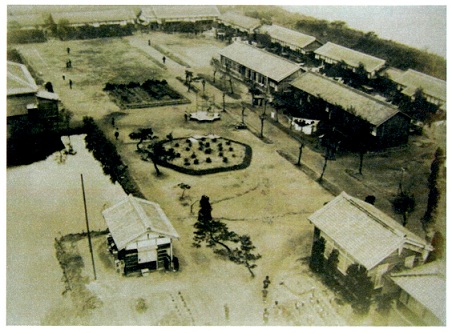 panoramic_photo 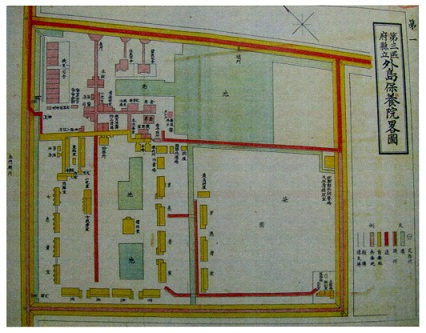 arrangement_plan 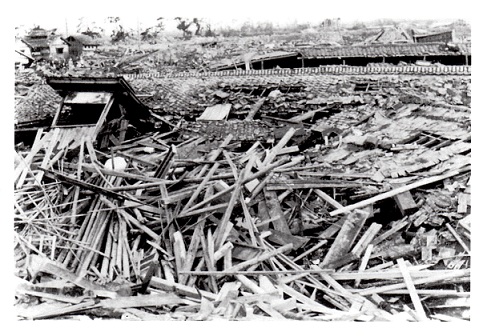 muroto_typhoon 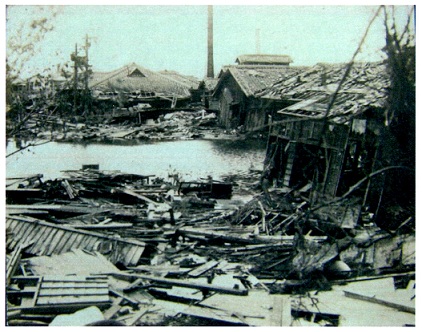 muroto_typhoon_02 |
長島からの出発1935 AugustThe state of the restored site of the Sotojima Hoyoin was discussed several times by Osaka Prefecture and the Department of the Interior and related prefectures. Eventually it was decided that a new sanatorium should be built in the west end of the Nagashima Island, as Nagashima Aiseien had already been built as the first national Hansen Disease sanatorium in the island. Thus two sanatoriums came to exist in this small island in Okayama prefecture. 1938 April 1 “The Third District Prefectural Sotojima Hoyoin” changed its name as “The Third District Prefectural Komyoen” and its construction finished on the April 27th at the present site. Compound area : 171,923 ㎡ Detail : Nagashima Island / Office buildings 125987 ㎡ , Residence 45936 ㎡ Opposite shore : Mushiage (Shioya) / Garage 900 ㎡ Residence 1402 ㎡ 1938 Among 416 patients who had been dispersed in sanatoriums in various parts of Japan,309 returned during June 20th and July 9th. Among those who did not return, some wished to remain in their place and some died there. Some however did not return,wishing to remain where they were, and died where they were. Details of those who returned: June 20 Matsuoka Hoyoen (20) July 7 Tama zenshoen (51) June 29 Kuriu-rakusenen (74) July 8 Kikuchi-keifuen (48) July 5 Nagashima-aiseien (65) July 9 Oshima-seishoen (61) The patients did not return to Komyoen immediately after it had been completed because impetigo had become epidemic in every sanatorium and they waited until the disinfection utilities could be set up in the facility. 1941 “The Third District Prefectural Komyoen” under the Osaka Prefecture was transferred to the national institution and it was named “National Leprosy Sanatorium Oku-komyoen”. At the same time, some lands of 172,027 ㎡ possessed by Osaka Prefecture became national estate. 1942 Some land of 116,337 ㎡(national estate) which was controlled by National Sanatorium Nagashima-aiseien became under the control of Oku-komyoen. Thus its area became 288,464 ㎡. 1943 April Hansen disease was formally called “tenkei-byo” or inherited disease, and was normally prejudiced and rejected. Therefore recruiting nurses was a quite difficult task since the sanatorium opened in 1909. In 1942, Komyoen applied for a permission to open a private nurse training school as set up under the nurses’ law. It was admitted and the students who studied there were eligible to take examinations authorized by a prefectural governor. Thus nurse training started in a self-sufficient manner. 1944 Having become the National institution, Komyoen reduced its personnel and it was run by 15 personnel including 5 medical doctors, and 71 hired staff. But as thirteen were called up for the war, two doctors including a medical superintendent, one head nurse,six nurses, and seven nurse trainees, totaling sixteen personnel, took care of 1100 patients. This meant one doctor looked after 550 patients and one nurse was responsible for 80 patients. 1945 From August to the winter season, the outbreak of dysentery in the sanatorium caused death of 213 patients. As there were 1134 patients then, that number counts 18.8% of the total. It was the largest amount of fatalities in the institutions history. 1946 In April 25th, Nagashima Island itself was transferred from the Ministry of Agriculture and Forestry to the Ministry of Health and Welfare. The land transferred from the Ministry of Agriculture and Forestry was 544,477 ㎡, and thus the Komyoen’s land was expanded to 832,840 ㎡. This was as five times as large as Komyoen’s initial site had when it initially began. 1946 In November 4th, the name “National Leprosy Sanatorium Oku-Komyoen” was changed to “National Sanatorium Oku-Komyoen”, the present name, leaving “Leprosy” out. 1950 March The law concerning Public health nurse, Midwifery and Nurse which had been established two years ago, made a landmark in the nursing system in Japan. But as Komyoen’s nursing training school could not correspond to it, it had to be closed. So Komyoen had to face difficulties in recruiting nurses again. 1953 August The “Leprosy(癩) Prevention Law” expressed in Chinese character was changed to the “Leprosy (らい)Prevention Law” expressed in Hiragana. 1954 April Owing to the newly established Practical Nurse (PN) system, Komyoen’s PN training school was approved and at last the hardship involved in recruiting nurses was solved. |
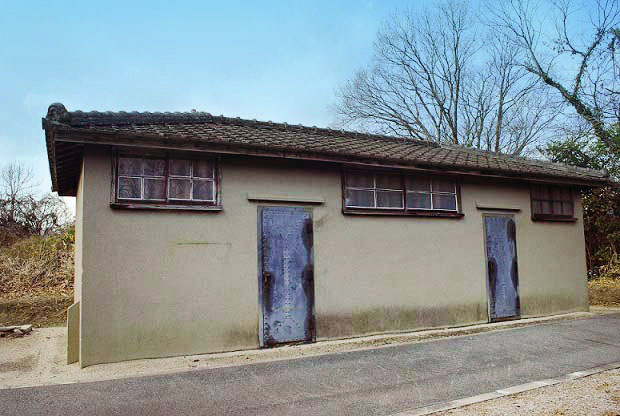 mush 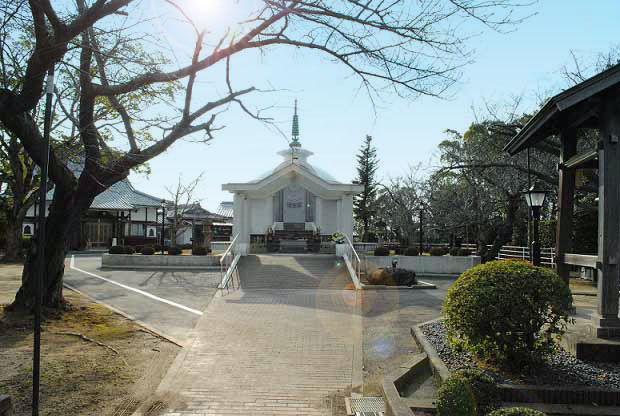 charnel 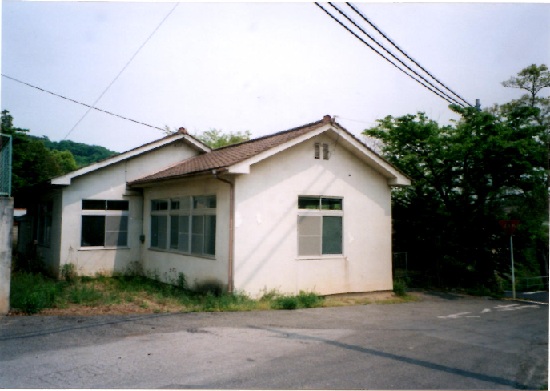 assistant_nursea_training_school 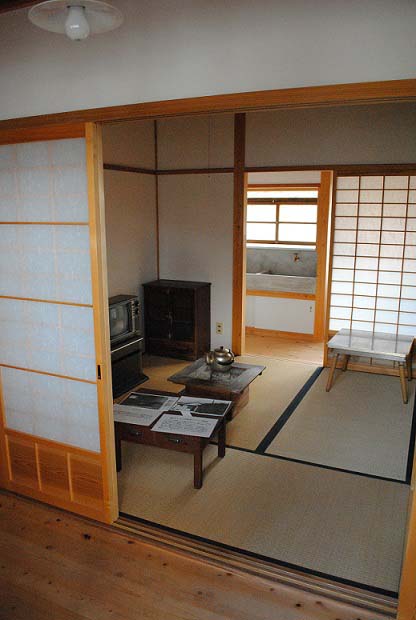 museum_an_room |
邑久長島大橋開通から現在へ1988 MayThe mainland and the Nagashima Island on which two sanatoriums stood, were separated by only by 30 m and there was a strong tidal current run between them. The only means of transportation to and from the island were either by a craft or a hand-rowing boat which was very inconvenient. Making a bridge over this small strait was a long wished desire for the patients and the staff of both Nagashima Aiseien and Komyoen. On May the 9th, the “Oku Nagashima O-hashi(bridge)”, generally called the “Bridge of Humanity Restoration” was completed, and the two lands were connected. This event brought Komyoen substantial changes. 1996 April The “Leprosy Prevention Law” was abolished and newly the “Law concerning the abolishment of the Leprosy Prevention Law” became effective. For many years, those who were in the sanatorium were called “patient”, and they were restricted in comings and goings from the institution. In this new Law, people were called “Person Admitted”and they were free to leave the institution as a legitimate right. However, aging and after effects of the disease, such as the vision disability or defects in extremities prevented many from social integration. Discrimination and prejudice against Hansen’sdisease also continued to stand as a barrier. 1997 March As the higher education sector grew the number of nurse training schools and colleges of nursing increased. Also, nurses started to work not only in mere hospital but also in the local community, and nurses with leadership were much desired. In that circumstance,the future of the Practical Nurses (PN) did not seem bright, and thus the training of PN’s as had been relied upon turned out to no longer guarantee the PN’s future. Furthermore, it was said that government should not pursue PN’s training any more.After 43 years of training, producing 538 graduates, Oku-komyoen’s PN training school was closed on March the 31st. 2009 April The “Law concerning the abolishment of the Leprosy Prevention Law” was abolished and newly “The Law concerning early solution on Hansen disease matter” (Generally called “Hansen disease Basic Act”) became effective. 2009 June In 1909, “The Third District Prefectural Sotojima-hoyoin” opened, and since then,Oku-komyoen celebrated its centennial. Lastly, although the “Leprosy Prevention Law” has been abolished, discrimination and prejudice against Hansen disease never fades out. Deep-seated feeling still does exist. Presently many local government bodies and organizations have supported enlightening activities so that Hansen’s disease might be better understood. Let’s create a bright society without discrimination and prejudice |
 Oku-Nagashima_bridge 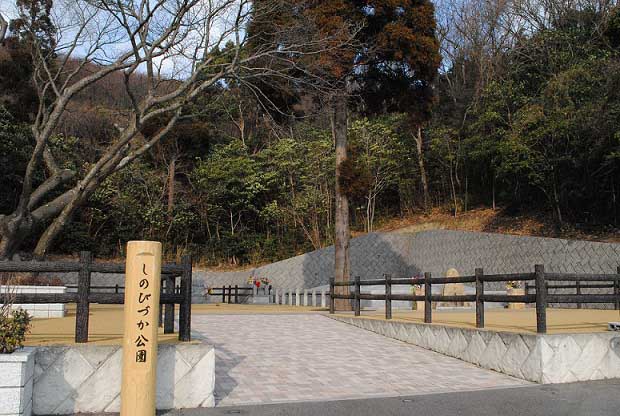 shinobiduka_Park  museum 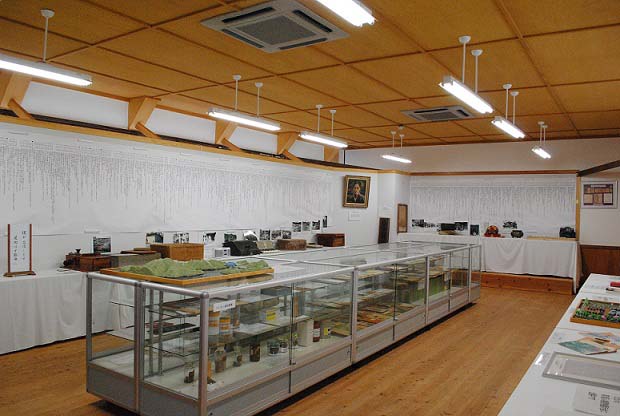 museum_an_inner |